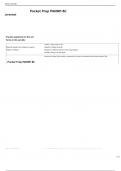9/9/24, 5:05 PM
Pocket Prep PMHNP-BC
Jeremiah
Practice questions for this set
Terms in this set (68)
• Justice: Doing what is fair
Ethical Principal Terms (Justice, Veracity, • Veracity: Telling the truth
Respect, Fidelity) • Respect: Treating everyone with equal dignity
• Fidelity: Being true and loyal
numerical values that enable a researcher to draw conclusions that extend beyond the
Pocket Prep PMHNP-BC
Inferential statistics immediate data alone. Examples include t-test, analysis of variance, Pearson's r
correlation, probability, and p-value.
1/10
, 9/9/24, 5:05 PM
are used to describe the basic features of the data in a study. They are numerical values
Descriptive statistics that summarize, organize and describe observations. Examples include mean, standard
deviation, and variance.
1.Introduction
Three phases of a therapeutic relationship 2.Working
3.Termination
Affect motor function and muscle movement
• Akathisia: motor restlessness, inability to remain still, rocking, pacing, or constant
motion of a unilateral limb, subjective sense of restlessness, often mistaken for
increasing anxiety
• Akinesia: absence of movement, difficulty initiating motion, subjective feeling of lack of
motivation to move, often mistaken for laziness or lack of interest
EPS Signs and Symptoms
• Dystonia: muscle spasticity usually in the back or neck, subjectively painful, often
mistaken for agitation
• Pseudo-Parkinson's: shuffling gait, motor slowing, mask-like facial expression, pill-
rolling; tremors, muscle rigidity
• Tardive dyskinesia: involuntary abnormal muscle movement of the mouth, tongue, face,
and jaw that may progress to limbs, can be irreversible, can occur as an acute process
at the initiation of medications or as a chronic condition at any point during treatment
The onset of symptoms in Alzheimer's disease follows this progression: (1) mood
changes, (2) cognitive impairment, (3) decline in functional independence, (4)
Progression of Alzheimer's behavioral and motor symptoms. Mood changes are usually manifested as apathy
rather than depression and are resistant to antidepressant medications but responsive
to cholinesterase inhibitors
Computer competency is the ability to demonstrate proficiency in the use of software
applications, such as Microsoft Word, Excel, and PowerPoint, and knowledge in
computer terminology, hardware selection, and simple maintenance functions.
Computer Competence vs. Literacy Computer literacy is the level of expertise and familiarity someone has with computers.
It generally refers to the ability to use an application rather than to write code.
Individuals who are very computer literate are called power users. Information literacy
involves recognizing when information is needed and being able to efficiently locate
and use it. Information competency is often used as a synonym for information literacy.
Countertransference represents the nurse practitioner's emotional reaction to the
patient based on his or her past experiences. Signs that indicate the presence of
countertransference include:
• Intense emotional reactions during the first encounter with the patient
• Recurrent anxiety or uneasiness while dealing with a patient
Counter-transference
• Uncharacteristic carelessness when following up with a patient
• Difficulty empathizing
• Resistance to others treating the patient
• Preoccupation or dreaming about the patient
• Frequently running overtime or cutting time short with patient
• Depression during or after an interaction with a patient
2/10




